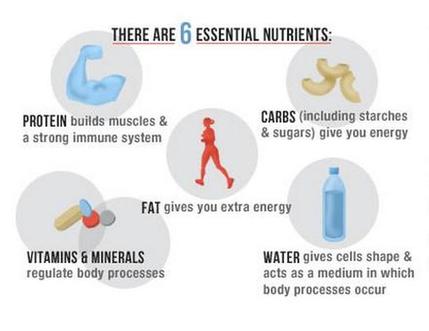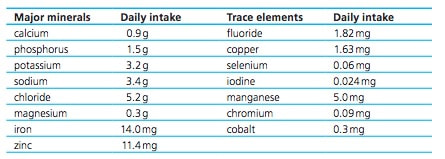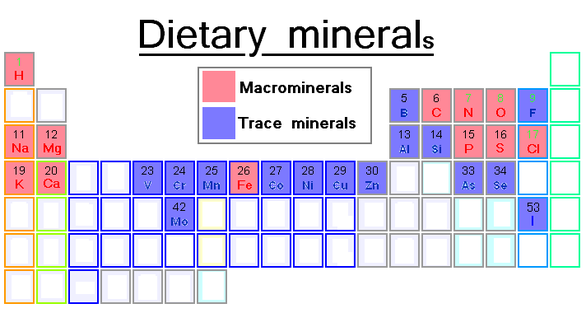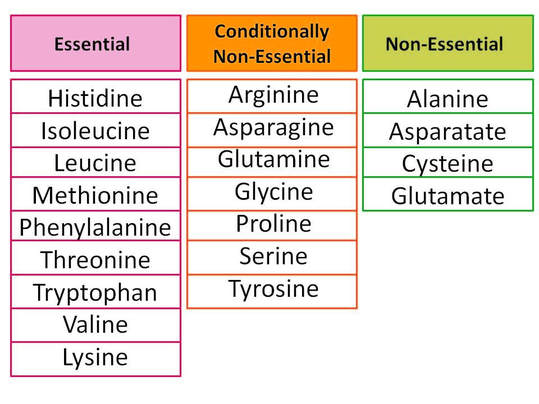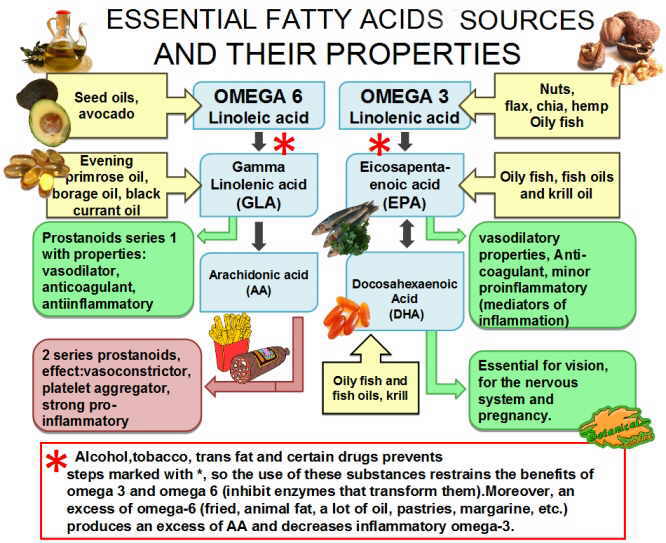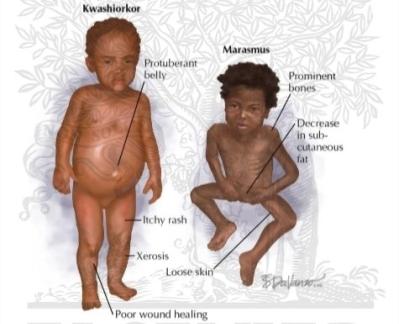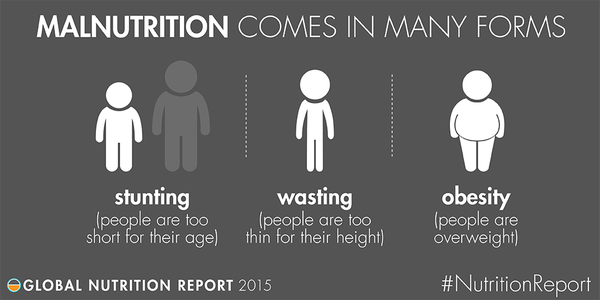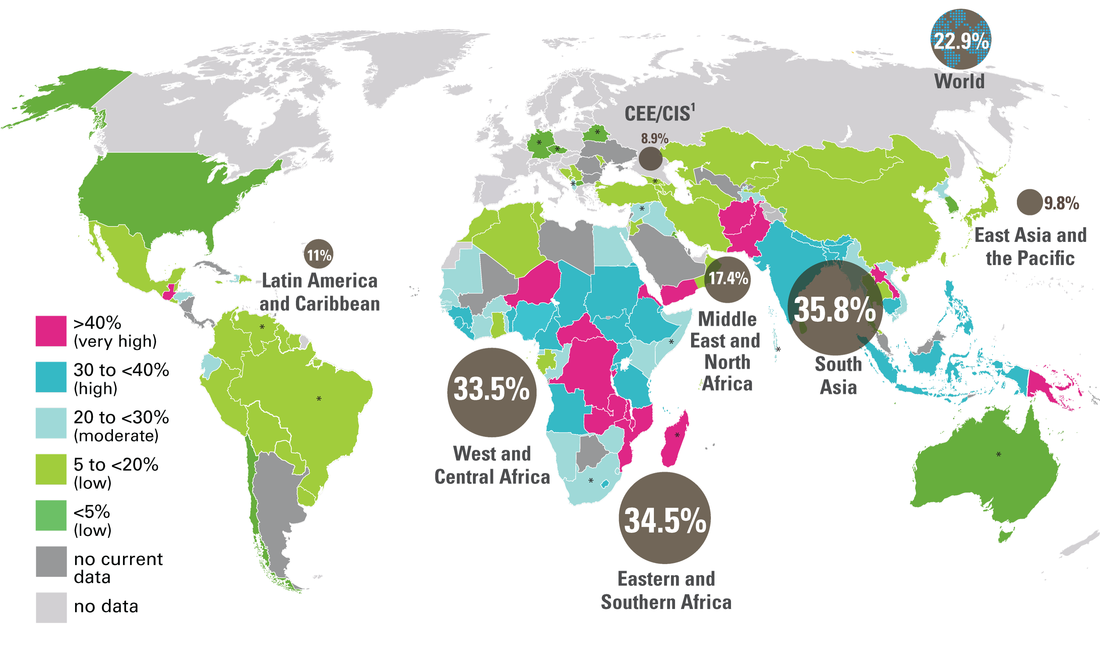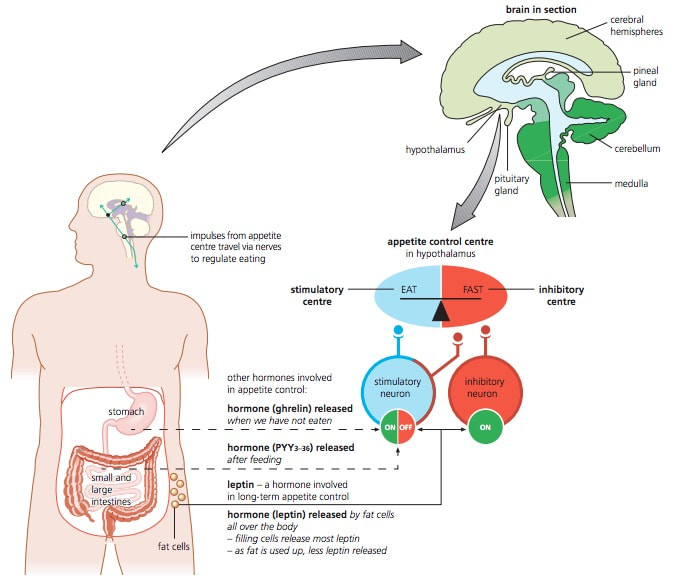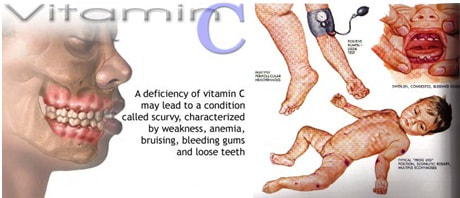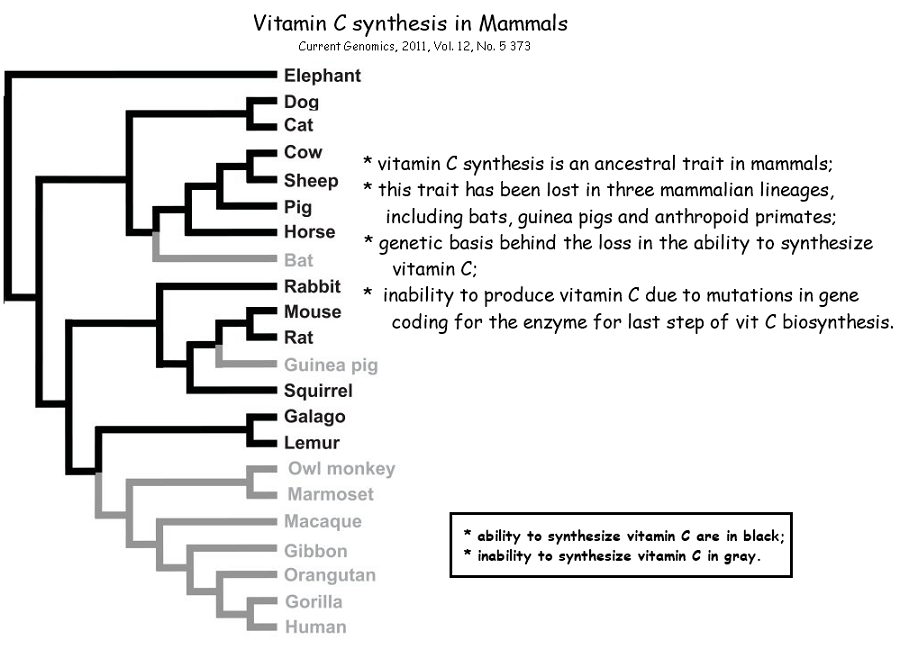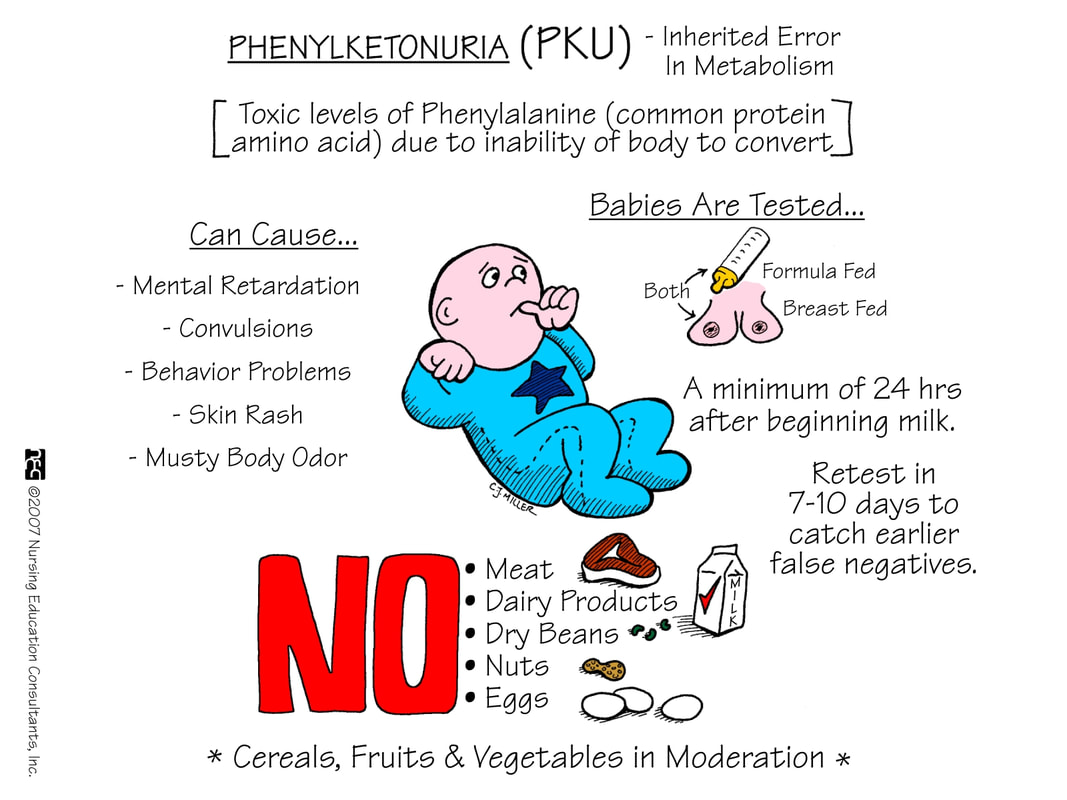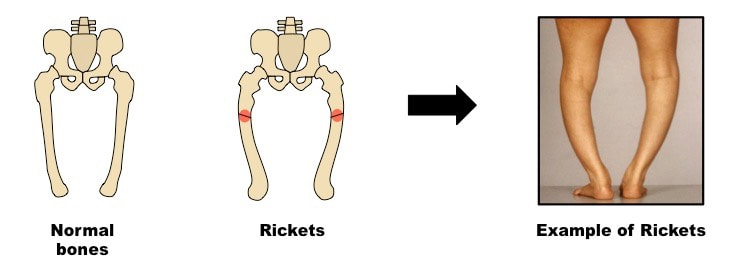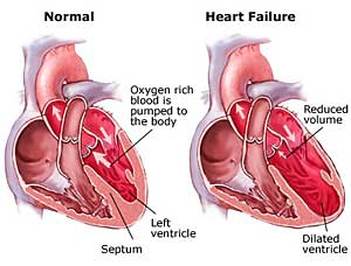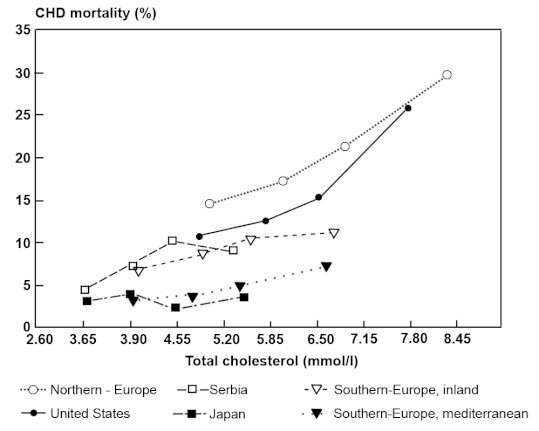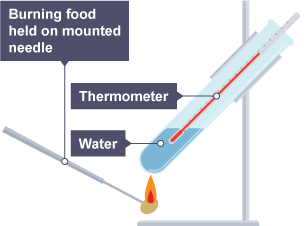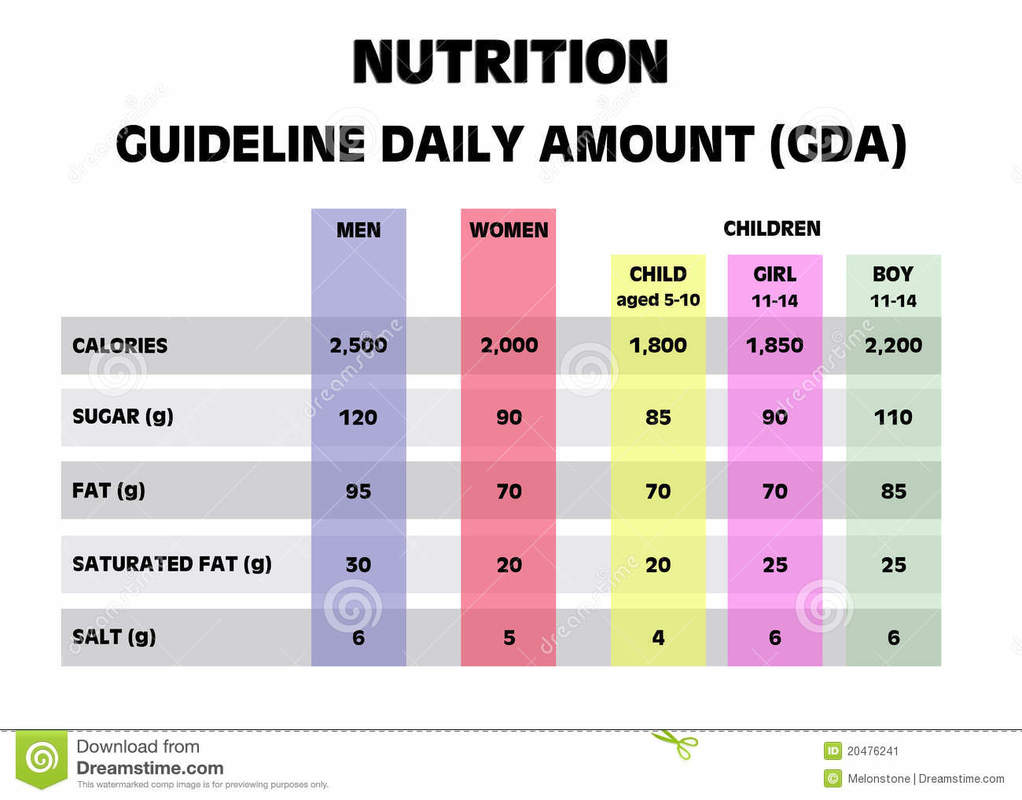D.1: human nutrition

In the Human Nutrition unit we will learn how
This unit will last 4 school days
This unit will last 4 school days
Essential idea:
- Essential idea: A balanced diet is essential to human health.
Nature of science:
- Falsification of theories with one theory being superseded by another—scurvy was thought to be specific to humans, because attempts to induce the symptoms in laboratory rats and mice were entirely unsuccessful. (1.9)
- Based on cladistics, explain why some animals are poor models for the study of scurvy.
- Based on cladistics, explain why some animals are poor models for the study of scurvy.
Understandings:
D.1 U 1 Essential nutrients cannot be synthesized by the body, therefore they have to be included in the diet.
- Define “essential” as related to dietary nutrients.
- Define “non-essential” as related to dietary nutrients.
A nutrient is a chemical substance found in foods that is used in the human body. There are six classes of nutrients – carbohydrates, proteins, lipids, vitamins, minerals and water
Essential nutrients:
An essential nutrient is a nutrient required for normal physiological function that cannot be replaced or synthesised by the body (e.g. niacin, choline), and thus must be obtained from a dietary source, e.g. water, minerals, some vitamins, some unsaturated fatty acids and some amino acids (10 out of 20)
Nonessential nutrients:
Nonessential nutrients are those nutrients that can be made by the body; they may often also be absorbed from consumed food however are not necessary in a diet, e.g. carbohydrates, sugars, some vitamins and minerals, some unsaturated fatty acids and some amino acids
Essential nutrients:
An essential nutrient is a nutrient required for normal physiological function that cannot be replaced or synthesised by the body (e.g. niacin, choline), and thus must be obtained from a dietary source, e.g. water, minerals, some vitamins, some unsaturated fatty acids and some amino acids (10 out of 20)
Nonessential nutrients:
Nonessential nutrients are those nutrients that can be made by the body; they may often also be absorbed from consumed food however are not necessary in a diet, e.g. carbohydrates, sugars, some vitamins and minerals, some unsaturated fatty acids and some amino acids
D.1.U 2 Dietary minerals are essential chemical elements. (Oxford Biology Course Companion page 663).
- State the difference between a vitamin and a mineral.
- List two example essential minerals.
Dietary minerals are chemical elements required as essential nutrients by organisms. Minerals present in common organic molecules are not considered essential – e.g. C, H, O, N, S
- Minerals include
- calcium (Ca)
- magnesium (Mg)
- iron (Fe)
- phosphorus (P)
- sodium (Na)
- potassium (K)
- chlorine (Cl)
D.1 U 3 Vitamins are chemically diverse carbon compounds that cannot be synthesized by the body. (Oxford Biology Course Companion page 663).
- Define vitamin.
- Given a molecular diagram of a vitamin, determine if t is hydrophobic or hydrophilic.
- Compare the properties of water soluble and fat soluble vitamins.
- List two example water soluble vitamins and two example fat soluble vitamins.
Vitamins have various purposes:
- cofactors for enzymes
- antioxidants
- hormones
D.1 U 4 Some fatty acids and some amino acids are essential.
- Outline the concept of “conditionally essential” using amino acid examples
An essential amino acid or indispensable amino acid is an amino acid that cannot be synthesized de novo by the organism, but must be supplied in its diet. The nine amino acids humans cannot synthesize are phenylalanine, valine, threonine, tryptophan, methionine, leucine, isoleucine, lysine, and histidine.
The term "essential fatty acid" refers to fatty acids required for biological processes but does not include the fats that only act as fuel. Essential fatty acids should not be confused with essential oils, which are "essential" in the sense of being a concentrated essence.
Only two fatty acids are known to be essential for humans: alpha-linolenic acid (an omega-3 fatty acid) and linoleic acid (an omega-6 fatty acid).
Some other fatty acids are sometimes classified as "conditionally essential," meaning that they can become essential under some developmental or disease conditions; examples include docosahexaenoic acid (an omega-3 fatty acid) and gamma-linolenic acid (an omega-6 fatty acid).
The term "essential fatty acid" refers to fatty acids required for biological processes but does not include the fats that only act as fuel. Essential fatty acids should not be confused with essential oils, which are "essential" in the sense of being a concentrated essence.
Only two fatty acids are known to be essential for humans: alpha-linolenic acid (an omega-3 fatty acid) and linoleic acid (an omega-6 fatty acid).
Some other fatty acids are sometimes classified as "conditionally essential," meaning that they can become essential under some developmental or disease conditions; examples include docosahexaenoic acid (an omega-3 fatty acid) and gamma-linolenic acid (an omega-6 fatty acid).
D.1 U 5 Lack of essential amino acids affects the production of proteins.
Protein cannot be made if there is a shortage of one or more essential amino acids - this is known as protein deficiency malnutrition and can come from a low intake of protein in the diet or an imbalance of the types of protein consumed. PDM can cause a lack of blood plasma proteins which can result in tissue fluid retention.
Kwashiorkor, also known as “edematous malnutrition” because of its association with edema (fluid retention), is a nutritional disorder most often seen in regions experiencing famine. It is a form of malnutrition caused by a lack of protein in the diet. People suffering from kwashiorkor typically have an extremely emaciated appearance in all body parts except their ankles, feet, and belly, which swell with fluid.
Kwashiorkor is rarely found in the United States and other countries with a generally steady food supply. It’s most common in sub-Saharan Africa and other countries where people routinely have a limited supply of food.
The extreme lack of protein causes an osmotic imbalance in the gastrointestinal system causing swelling of the gut diagnosed as an edema or retention of water.
Kwashiorkor, also known as “edematous malnutrition” because of its association with edema (fluid retention), is a nutritional disorder most often seen in regions experiencing famine. It is a form of malnutrition caused by a lack of protein in the diet. People suffering from kwashiorkor typically have an extremely emaciated appearance in all body parts except their ankles, feet, and belly, which swell with fluid.
Kwashiorkor is rarely found in the United States and other countries with a generally steady food supply. It’s most common in sub-Saharan Africa and other countries where people routinely have a limited supply of food.
The extreme lack of protein causes an osmotic imbalance in the gastrointestinal system causing swelling of the gut diagnosed as an edema or retention of water.
D.1 U 6 Malnutrition may be caused by a deficiency, imbalance or excess of nutrients in the diet.
Malnutrition comes from an unbalanced diet, where the consumption of nutrients is low, lacking or there is an excess consumption of fats and refined carbohydrates. Starvation and obesity are examples of malnutrition
D.1 U 7 Appetite is controlled by a centre in the hypothalamus.
Appetite is controlled by hormones (leptin, insulin, CCK) produced in the pancreas, small intestine and adipose tissue. These send messages to the appetite control centre of the brain (hypothalamus), causing a person to feel that they have eaten enough (satiety). The release of hormones can be triggered in a number of ways:
- Stretch receptors in the stomach lining may become activated when the stomach is full
- Adipose tissue may release hormones (leptin) in response to fat storage
D 1 U 8 Overweight individuals are more likely to suffer hypertension and type II diabetes.
Changes in diet and appetite control may result in individuals over-indulging or under-indulging during meals
Obese individuals have more fatty tissue that causes an increase in their vascular resistance and thus increases the 'work' the heart has to do in order to pump blood around the body. This can result in hypertension for Diabetes.
- Individuals who overeat are likely to gain weight and develop obesity-related illnesses
- Individuals who undereat are likely to lose weight and exhibit starvation symptoms
Obese individuals have more fatty tissue that causes an increase in their vascular resistance and thus increases the 'work' the heart has to do in order to pump blood around the body. This can result in hypertension for Diabetes.
- Hypertension is high blood pressure.
- II diabetes is the body's inability to react to insulin or a resistance to insulin.
D 1 U 9 Starvation can lead to breakdown of body tissue.
- State the cause of starvation.
- Explain loss of muscle mass during starvation.
1. Body uses glycogen stores
2. Body begins to break down its own tissue - uses amino acids as energy source
3. Body breaks down its muscle mass as a last resort
2. Body begins to break down its own tissue - uses amino acids as energy source
3. Body breaks down its muscle mass as a last resort
Applications:
D.1 A 1 Production of ascorbic acid by some mammals, but not others that need a dietary supply.
- State the function of ascorbic acid, Vitamin C.
- Analyze a cladogram based on the mutations in the GLO gene, used in Vitamin C synthesis.
- Outline the cause, symptoms and treatment of scurvy.
Ascorbic acid is a form of vitamin C that is required for a range of metabolic activities in all animals and plants Vitamin C must be obtained by the body in sufficient quantities from the consumption of vitamin C-rich foods, including citrus fruits, cabbage and tomatoes.
Antioxidants protect the body against the destructive effects of free radicals - they neutralize free radicals by donating one of their own electrons, ending the electron-"stealing" reaction. Free radical damage accumulates with age and can thus contribute to the development of health conditions such as cancer, heart disease and arthritis.
Humans do not produce Vitamin C due to a mutation in the GULO (gulonolactone oxidase) gene, which results in the inability to synthesise the protein. Normal GULO is an enzyme that catalyses the reaction of D-glucuronolactone with oxygen to L-xylo-hex-3-gulonolactone.
- Vitamin C is critical for the growth and repair of tissues in all areas of the body
- It assists the body in the production of collagen, an important protein used to form skin, cartilage, tendons, ligaments and blood vessels
- Vitamin C is required for healing wounds as well as repairing and maintaining bones and teeth
- It also allows the body to absorb iron from non-heme sources
- Vitamin C is an antioxidant, along with vitamin E, beta-carotene and many other plant-based nutrients
Antioxidants protect the body against the destructive effects of free radicals - they neutralize free radicals by donating one of their own electrons, ending the electron-"stealing" reaction. Free radical damage accumulates with age and can thus contribute to the development of health conditions such as cancer, heart disease and arthritis.
Humans do not produce Vitamin C due to a mutation in the GULO (gulonolactone oxidase) gene, which results in the inability to synthesise the protein. Normal GULO is an enzyme that catalyses the reaction of D-glucuronolactone with oxygen to L-xylo-hex-3-gulonolactone.
D.1 A 2 Cause and treatment of phenylketonuria (PKU). (Oxford Biology Course Companion page 667)
- Outline the genetic cause of phenylketonuria.
- List consequences of phenylketonuria if untreated.
- State how phenylketonuria is treated.
Causes and Consequences of Phenylketonuria:
- A genetic mutation changes the gene coding for tyrosine hydroxylase, which is responsible for metabolising phenylalanine into tyrosine
- Phenylalanine is instead converted into phenylpyruvic acid, resulting in a high level of ketones in the blood and urine
- Over time, this may result in brain damage and mental retardation
Diagnosis and Treatment of Phenylketonuria:
- Diagnosis can be made by a simple blood test for the levels of phenylalanine – this test is conducted shortly after birth
- As PKU results in the build up of phenylalanine in the bloodstream, it is treated by following a diet that is low in protein
- Diet should include fruits, grains, vegetables and special formula milk and must be undertaken from early in life or else symptoms will appear
- Symptoms may include tremors, seizures, eczema, skin rashes and eventually brain damage (mental retardation)
D.1 A 3 Lack of Vitamin D or calcium can affect bone mineralization and cause rickets or osteomalacia. (Oxford Biology Course Companion page 668).
- Explain the relationship between vitamin D, calcium, osteomalacia and skin cancer.
Calcium and vitamin D work together to protect your bones—calcium helps build and maintain bones, while vitamin D helps your body effectively absorb calcium.
A diet deficient in vitamin D in conjunction with inadequate sun exposure causes osteomalacia (or rickets when it occurs in children), which is a softening of the bones. In the developed world, this is a rare disease. However, vitamin D deficiency has become a worldwide issue in the elderly and remains common in children and adults. Low blood calcidiol (25-hydroxy-vitamin D) can result from avoiding the sun. Deficiency results in impaired bone mineralization and bone damage which leads to bone-softening diseases.
- UV light causes the skin to synthesise vitamin D, where it is stored in the liver for when UV levels are low (i.e. during the winter seasons)
- Insufficient sun exposure may lead to skeletal deformities (i.e. rickets) due to insufficient vitamin D levels
- However high levels of UV light can damage skin cells and cause skin cancers (malignant melanomas), so exposure must be limited
- Using sun block and covering skin with clothing will prevent UV radiation reaching the skin, inhibiting vitamin D production
- Certain diets (e.g. vegans, vegetarians) are more likely to result in a lack of vitamin D, so that such people need more exposure to sunlight
- Individuals with darker skin pigmentation produce vitamin D more slowly, but are better protected against skin cancers
- Certain ethnicities may be at a greater risk of vitamin D deficiency due to cultural or religious practices (e.g. Muslims wearing a burqa)
- Including vitamin D supplements in the diet can reduce the risk of vitamin D deficiency without requiring sun exposure
A diet deficient in vitamin D in conjunction with inadequate sun exposure causes osteomalacia (or rickets when it occurs in children), which is a softening of the bones. In the developed world, this is a rare disease. However, vitamin D deficiency has become a worldwide issue in the elderly and remains common in children and adults. Low blood calcidiol (25-hydroxy-vitamin D) can result from avoiding the sun. Deficiency results in impaired bone mineralization and bone damage which leads to bone-softening diseases.
D.1 A 4 Breakdown of heart muscle due to anorexia.
- List symptoms associated with anorexia nervosa.
- Outline the effect of anorexia nervosa on heart muscle tissue.
Anorexia nervosa is an eating disorder characterised by self-starvation and excessive weight loss. Malnutrition starves body tissues, thus the heart walls can become thin and weak which causes the heart chambers to enlarge . The pumping function of the heart declines and blood pressure falls. Organs that are sensitive to blood pressure e.g. the liver and kidney begin to fail.
D.1 A 5 Cholesterol in blood as an indicator of the risk of coronary heart disease
- Outline factors that indicate that dietary cholesterol may not be the exclusive cause of the correlation between blood plasma cholesterol levels and risk of coronary heart disease.
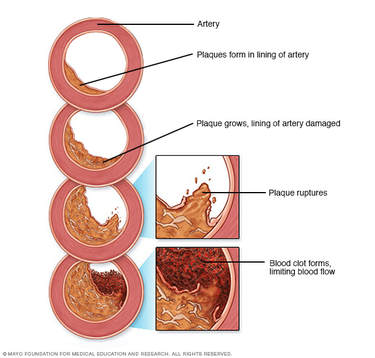 image from Mayo Clinic
image from Mayo Clinic
Cholesterol is required for cell membrane structure and steroid synthesis, but very little (~20%) cholesterol comes from the diet. High cholesterol diets can lead to atherosclerosis, as characterised by the deposition of fatty plaques and subsequent hardening of the arteries. However the risks are increased when high levels of saturated fats are combined in the diet.
High levels of saturated fats also cause atherosclerosis, but also raise levels of LDL (low density lipoprotein) which retains cholesterol in the body. Reducing dietary cholesterol levels will likely only be effective in lowering the risk of coronary heart disease if it is combined with lower levels of saturated fats as part of a balanced diet.
Arteries supplying the heart become narrowed and the blood supply to cardiac tissues is reduced. Heart has to work harder to force blood through narrowed vessels / blood pressure increases.
Angina
Cholesterol:
Low density lipoproteins LDL's:
High density lipoprotein HDL's:
Smoking:
Treatment:
Prevention is more cost effective than treatment
High levels of saturated fats also cause atherosclerosis, but also raise levels of LDL (low density lipoprotein) which retains cholesterol in the body. Reducing dietary cholesterol levels will likely only be effective in lowering the risk of coronary heart disease if it is combined with lower levels of saturated fats as part of a balanced diet.
Arteries supplying the heart become narrowed and the blood supply to cardiac tissues is reduced. Heart has to work harder to force blood through narrowed vessels / blood pressure increases.
Angina
- Chest pain due to severe shortage of blood to the heart muscle - cells do not die
- Pain only occurs during activity but not at rest
- Caused by narrowing of coronary arteries (atherosclerosis)
- Heart attack (myocardial infarction)
- When a coronary artery is totally blocked by a thrombus/embolus
- No blood supply to heart muscle and cells die - often fatal
- Blockage leads to damage of heart muscle and to gradual weakening of muscle
- Less efficient pumping
- Often accumulation of blood on right side → enlargement of heart
- Causes:
- The main cause is atherosclerosis
- Often called hardening of the arteries
- Inner layer of artery wall thickens with deposits of
- Cholesterol
- Fibrous (scar) tissue
- Dead muscle cells
- Blood platelets
- Fats, in the form of lipoproteins, accumulate beneath the endothelium
- Form plaque on the wall of arteries, also called atheroma
- Arteries become less elastic and partially narrowed
- Accelerated by high blood pressure
- Arterial endothelium damage is more likely but also leads to further weakening
- Aneurysm: weak walls may burst leading to severe loss of blood (haemorrhaging)
- Brain aneurysm is called a stroke
- Atheroma increases the risk of blood clotting
- Thrombus (blood clot) may break away and lodge elsewhere in the circulation (e.g. brain, heart)
- Circulating thrombus is called an embolus
Cholesterol:
- Cholesterol has important functions and is needed for
- Vitamin D production in skin
- Sex hormone production in gonads and adrenal glands
- Making cell membranes
- Make bile acid (salts)
- Cholesterol is an alcohol, not a fat but has properties similar to fats - soft, waxy and insoluble (difficult to remove if deposits form)
- Cholesterol is transported in the blood stream from the liver to tissues
- Safe transport is needed due to its insolubility
- This is achieved by lipoproteins, which are soluble fatty proteins
- These are wrapped around the cholesterol
- Usually, only small amounts of free cholesterol escape
- Fatty streaks adhere to wall of arteries - Atheroma/atherosclerosis/plaque forms
- Narrows lumen of artery
- Damages endothelium
- Can lead to formation of thrombus/blood clot
Low density lipoproteins LDL's:
- Carry cholesterol from the liver to the tissues
- Normal levels: some cholesterol 'leaks' from the lipoprotein and is absorbed to build cell membranes
- High levels:
- Too much cholesterol leaks out
- Cholesterol is deposited on the arterial walls
- White blood cells are trapped within the cholesterol
- Free radicals are released by white blood cells and react with cholesterol
- This damages artery wall which allows further cholesterol deposits (i.e. Atherosclerosis)
- Blood platelets are activated and stick to damaged areas releasing clotting factors (thromboxanes)
- Healthy arteries produce anti-clotting factors (prostaglandins)
- Normally a balance between these two. Healthy vessels do not form clots
High density lipoprotein HDL's:
- Carry cholesterol away from tissues, including artery walls
- Travels to liver, is broken down and removed with bile
Smoking:
- Reduces levels of antitoxidants (vitamins), more damage due to release of free radials by phagocytes
- Nicotine constricts arteries causes platelets to stick together → vasoconstriction → heart must work harder to force blood through → increases blood pressure
- Raises conc. of fibrinogen (in blood) → increased risk of clotting
- Higher blood pressure causes damage to blood vessel lining/endothelium/collagen [EXAM]
- Leads to rise on blood platelets and makes them more sticky/form a plug/adhere to collagen fibres
- Release of thromboplastin/thrombokinase
- Fibrinogen converted to insoluble fibrin
- Platelet plug trapped by fibrin mesh
- Raises blood cholesterol by causing a rise in LDLs in blood
- Carbon monoxide reduces the efficiency of the blood in terms of carrying oxygen
- Haemoglobin combines with CO more readily than with oxygen → forms carboxyheamoglobin
- Associated with plaque formation
- Principle CHD = heart muscle receives inadequate amount of blood or oxygen/(coronary) blood supply reduced
Treatment:
- Lower blood pressure
- Drugs which regulate heart rate/beat - prevent abnormal rhythms (beta blockers)
- Drugs which prevent blood clotting making thrombosis less likely (warfarin)
- Heart by-pass
- Vein from the leg is used to by-pass the blocked region of the coronary artery
- Involves open heart surgery
- Angioplasty
- Deflated balloon-like device is passed up to the heart via the aorta
- Guided into damaged coronary artery and inflated to stretch the artery
- Transplant
- Need to find a suitable donor
- Need to prevent rejection → drugs that suppress immune system needed for rest of life
Prevention is more cost effective than treatment
- Screen the population for
- High blood pressure
- High cholesterol
- Stop smoking, healthier diet, more exercises
- Men over 35 are at highest risk
- Monitor the behaviour of the heart during exercise
- Difficult but encouraging the population to adopt a more healthy lifestyle from an early age is important
- Often leads to changes in diet and weight management
- Giving up smoking and reducing alcohol intake
- Reduces blood pressure
- Many people do not heed the advice until it is too late
- Coronary heart disease is a long-term degenerative disease, starts at birth
Skill
D.1 S 1 Determination of the energy content of food by combustion.(Oxford Biology Course Companion page 669)
- Explain how a calorimeter can be used to determine the energy content in food.
- Calculate the energy content of a food sample using calorimetry data.
You can determine energy content of food by burning a portion of it and capturing the heat released to a known amount of water. This technique is called calorimetry. The energy content of the food is the amount of heat produced by the combustion of 1 gram of the food, and is measured in kilojoules per gram (kJ/g).
D.1 S 2 Use of databases of nutritional content of foods and software to calculate intakes of essential nutrients from a daily diet. (Oxford Biology Course Companion page 670).
- Use a computer application to keep a record of food consumed in a single day.
- Compare tracked food intake to the recommended intake of nutrients.
The recommended daily intake for a nutrient (RDI) is the daily dietary level required to meet the requirements of health. It is an estimate only and will vary according to age, gender, activity levels and medical conditions. The recommendations are based on a daily energy intake of 8400 kJ (2000 kcal) for healthy adults
Key Terms
|
nutrient
amino acid diet fatty acid mineral essential nutrients fat soluble diabetes mellitus cardiovascular bone mineralization |
vitamin
non-essential hydrophobic amino acids malnutrition starvation calcium heart disease osteomalacia melanin |
scurvy dietary supplement
food label rickets organic molecule inorganic molecule hydrophilic conditionally essential ascorbic acid calorimeter cholesterol |
balanced diet
deficiency PKU blood plasma omega-6 water soluble protein deficiency diabetes vitamin C vitamin D |
appetite control
hypothalamus hypertension caladogram anorexia nervosa wasting IDD HDL LDL |
Classroom Materials
Analyse your lunch with Wolfram|Alpha
Calorimety Lab
Molley's World
Facts About Hunger
Hunger Statistics
Topic D.1 Review
Analyse your lunch with Wolfram|Alpha
Calorimety Lab
Molley's World
Facts About Hunger
Hunger Statistics
Topic D.1 Review
PowerPoint and Notes on Topic D.1 by Chris Payne
Your browser does not support viewing this document. Click here to download the document.
Your browser does not support viewing this document. Click here to download the document.
Correct use of terminology is a key skill in Biology. It is essential to use key terms correctly when communicating your understanding, particularly in assessments. Use the quizlet flashcards or other tools such as learn, scatter, space race, speller and test to help you master the vocabulary.
Useful Links
Food Tracker USDA
BBC Health guidelines on drinking water.
Scientific American article on water requirements.
Mediterranean Diet
Scientific Case for Banning Transfats
5 Vitamins and Minerals
International Mindedness
- The Vitamin and Mineral Nutrition Information System (VMNIS), formerly known as the Micronutrient Deficiency Information System (MDIS), was established in 1991 following a request by the World Health Assembly to strengthen surveillance of micronutrient deficiencies at the global level.
TOK
- There are positive effects of exposure to sun such as the production of Vitamin D as well as health risks associated with exposure to UV rays. How can conflicting knowledge claims be balanced?
Video Clips
Metabolism is a complex process that has a lot more going on than personal trainers and commercials might have you believe. Today we are exploring some of its key parts, including vital nutrients -- such as water, vitamins, minerals, carbs, fats, and proteins -- as well as how anabolic reactions build structures and require energy, while catabolic reactions tear things apart and release energy
An intermittent fasting diet is one of the hippest new nutrition and fitness philosophies, based around the idea that going hungry can be good for your health. Some think it’s a weight loss secret that calls upon our ancient evolutionary programming. We look at the science behind intermittent fasting.
The things we eat and drink on a daily basis can impact our health in big ways. Too many carbohydrates, for instance, can lead to insulin resistance, which is a major contributor to cardiovascular disease and Type 2 Diabetes. But what are carbs, exactly? And what do they do to our bodies?
As the narrative goes, fat is bad. Well, it's actually more nuanced than that. The type of fat you eat is more impactful on your health than the quantity. George Zaidan examines triglycerides, the varied molecules that make up fat, and how to identify which types of fat you are consuming.
Vitamins are the building blocks that keep our bodies running; they help build muscle and bone, capture energy, heal wounds and more. But if our body doesn’t create vitamins, how do they get into our system? Ginnie Trinh Nguyen describes what vitamins are, how they get into our bodies -- and why they are so crucial.
Humans have worried about toxins since Ancient Egypt. We can relax.
Ellen Gustafson is the co-founder of FEED projects. In her informative talk, she uses the hunger and obesity crisis to help her audience think about the importance of developing holistic long-term, systemic solutions to how to make
the food systems better internationally.. Check it out, and then take action
the food systems better internationally.. Check it out, and then take action
Obesity is an escalating global epidemic. It substantially raises the probability of diseases like diabetes, heart disease, stroke, high blood pressure, and cancer. But what is the distinction between being overweight and being obese? And how does a person become obese? Mia Nacamulli explores obesity.
What is anorexia nervosa? Anorexia nervosa is a type of eating disorder in which somebody becomes obsessed with what they eat, and leads to abnormally low body weight
We hear about calories all the time: How many calories are in this cookie? How many are burned by doing 100 jumping jacks, or long-distance running, or fidgeting? But what is a calorie, really? And how many of them do we actually need?
